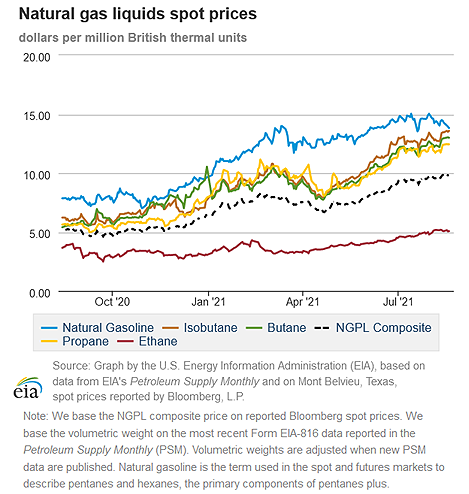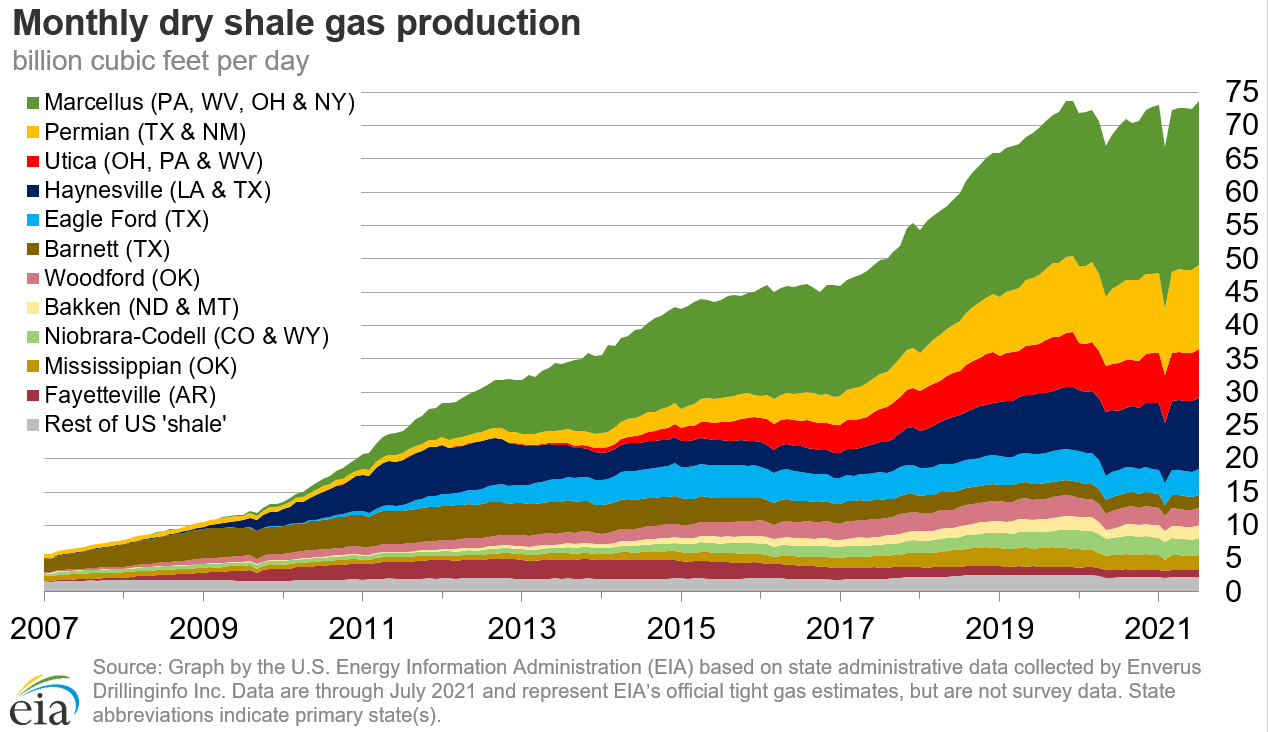In the News:
Higher petrochemical demand for propane to outweigh lower demand for grain drying and space heating this winter
In our latest Short-Term Energy Outlook (STEO), we expect 2% more U.S. propane consumption from October through December compared with last year, reflecting higher demand for propane as a petrochemical feedstock. This increase occurs despite expectations of lower demand for corn grain drying and a forecast for warmer winter weather. Non-feedstock consumption is expected to be especially high in the Midwest (PADD 2), where 42% of U.S. homes use propane as a primary space heating fuel and where 90% of the U.S. corn crop is grown.
Similar to natural gas consumption in the residential and commercial sectors, propane consumption outside the industrial sector is highly seasonal. Two-thirds of annual propane consumption occurs during the winter heating season (October through March) because of peak demand for both residential space heating and agricultural grain drying. Agricultural demand for grain drying occurs early in the heating season, usually peaking in October or November, but demand can vary year to year.
The U.S. Department of Agriculture estimates that this year’s corn crop will reach maturity earlier than the 10-year average due to a relatively warm and dry autumn. When the corn crop reaches maturity in late September or early October, producers can postpone harvest to late October to allow the crop to dry in the field. This postponement reduces the demand for propane for commercial grain drying. By comparison, in 2013, when the corn harvest occurred late in the season and the grain moisture content was high, October propane consumption in the Midwest reached 408,000 barrels per day (b/d), 60% above 10-year average from 2011-2020. Similar conditions in 2019 pushed the corn harvest into November, resulting in the highest propane consumption for the month since EIA began reporting this data in 2010, and exceeding the 10-year average by 28%, or 381,000 b/d.
The winter forecast from the National Oceanic and Atmospheric Administration calls for average to above-average temperatures across most of the Midwest and all of the Northeast, which suggests lower residential and commercial heating demand for propane. According to the American Community Survey, propane is a primary heating fuel in 4.3% of all U.S. households. However, it is a primary space heating fuel in 6.6% of homes in the Midwest and 6.0% of homes in New England. In some of the northern states, such as Minnesota, Wisconsin, or New Hampshire, where heating demand is highest, the share of homes using propane as a primary heating fuel can exceed 10%.
We expect elevated use of propane as a petrochemical feedstock to fully offset the lower consumption for crop drying and heating. The petrochemical industry uses propane for the production of propylene, which had a premium to propane of over 50¢/lb for multiple months in 2021. The propylene to propane premium has not been above 50¢/lb since 2014. Due to this increase in industrial consumption, we expect total propane consumption for the first half of the 2021–22 winter heating season to average 1.3 million b/d, or 1.7% higher, than the 10-year average level and 25,000 b/d higher than the first half of the 2020–21 winter.
Overview:
(For the week ending Wednesday, August 18, 2021)
- Natural gas spot prices fell at most locations this report week (Wednesday, August 11 to Wednesday, August 18). The Henry Hub spot price fell from $4.07 per million British thermal units (MMBtu) last Wednesday to $3.86/MMBtu yesterday.
- The price of the September 2021 NYMEX contract decreased 21¢, from $4.059/MMBtu last Wednesday to $3.852/MMBtu yesterday. The price of the 12-month strip averaging September 2021 through August 2022 futures contracts declined 15¢/MMBtu to $3.668/MMBtu.
- The net injections to working gas totaled 46 billion cubic feet (Bcf) for the week ending August 13. Working natural gas stocks totaled 2,822 Bcf, which is 16% lower than the year-ago level and 6% lower than the five-year (2016–2020) average for this week.
- The natural gas plant liquids composite price at Mont Belvieu, Texas, rose by 22¢/MMBtu, averaging $9.83/MMBtu for the week ending August 18. Propane prices, which rose 5%, are now at their highest level since February 2014. On a heat-content equivalent basis ($/MMBtu) propane prices rose above Brent crude oil and are at a 5% premium to crude oil, the widest such premium since October 2017. Normal butane and isobutane prices also remain elevated, increasing 4% and 5%, respectively. Natural gasoline and ethane prices each fell 2%. Natural gasoline prices followed Brent crude oil prices, which also fell 2% for the week ending August 18. Ethane prices declined in response to a 5% decrease in natural gas prices at the Houston Ship Channel, as well as the 14% decrease in weekly average ethylene prices.
- According to Baker Hughes, for the week ending Tuesday, August 10, the natural gas rig count decreased by 1 to 102. The number of oil-directed rigs rose by 10 to 397, led by drilling in the Bakken play, which gained 3 rigs (2 in North Dakota and 1 in Montana). The Permian Basin in Texas and New Mexico gained one rig and now accounts for 61% of all active oil-directed rigs, the lowest share of the total since the last week of March 2020. The total rig count increased by 9, and it now stands at 500.
Prices/Supply/Demand:
Prices at the Henry Hub, the main NYMEX trading hub, decline week over week, reflecting lower demand at the end of the report week. This report week (Wednesday, August 11 to Wednesday, August 18), the Henry Hub spot price fell 21¢ from $4.07/MMBtu last Wednesday to a weekly low of $3.86/MMBtu yesterday.
Temperatures in the Midwest moderate, reducing demand for natural gas for power generation as air conditioning demand falls. At the Chicago Citygate, prices fell throughout the report week, declining 23¢ from $3.95/MMBtu last Wednesday to a weekly low of $3.72/MMBtu yesterday. Temperatures throughout the Midwest averaged below normal for this time of year through most of the report week. In Chicago, the average temperature declined as low as 71°F, or 4°F below normal, on Sunday, before returning to near normal at the end of the report week.
California prices decline as alternative sources of natural gas supply compensate for reduced deliveries through the El Paso Natural Gas (EPNG) pipeline. The price at PG&E Citygate in Northern California fell 28¢, down from $5.44/MMBtu last Wednesday to a weekly low of $5.16/MMBtu yesterday. The price at Sumas on the Canada-Washington border fell 30¢ from $3.80/MMBtu last Wednesday to $3.50/MMBtu yesterday. IHS Markit reports increased imports of natural gas from Canada into the Pacific Northwest, averaging 250 million cubic feet per day (MMcf/d) higher than last week, with most of this volume making its way into the California market, more than offsetting reduced flows into California from the Southwest.
The price at SoCal Citygate in Southern California decreased $2.71 from $7.48/MMBtu last Wednesday to $4.77/MMBtu yesterday. Prices at SoCal Citygate rose as high as $7.65/MMBtu on Monday, in response to Kinder Morgan’s declaration of a force majeure (Notice ID 612627) on their EPNG pipeline. EPNG Line 2000 suffered a rupture, causing a fire near Coolidge, Arizona. Flows on the 30-inch line segment near Coolidge were reduced from approximately 500 MMcf/d before the incident to approximately 200 MMcf/d on August 15 and to zero from Monday, August 16, until further notice. Offsetting some of the pipeline capacity losses, the Kern River Gas Transmission (KRGT) Company announced an end to a previously reported force majeure following an outage at the Veyo Compressor Station, which reduced flows of natural gas from the Rockies production area to Southern California by approximately 100 MMcf/d. Maintenance on the Overthrust Pipeline, which delivers Rockies natural gas production into KRGT, has also been delayed (Notice ID 30057). Initially scheduled (Notice ID 29997) to start yesterday, the maintenance would have reduced KRGT receipts by approximately 260 MMcf/d for three days. Dominion Energy, operator of the Overthrust Pipeline, now plans to begin maintenance on August 24.
Prices in the Northeast decline in response to cooler temperatures and lower demand for electric power generation. At the Algonquin Citygate, which serves Boston-area consumers, the price went down $1.02 from $4.90/MMBtu last Wednesday to $3.88/MMBtu yesterday. At the Transcontinental Pipeline (Transco) Zone 6 trading point for New York City, the price decreased 26¢ from $4.09/MMBtu last Wednesday to $3.83/MMBtu yesterday. Prices at both Algonquin Citygate and Transco Zone 6 reached their lowest levels on Friday, at $3.66/MMBtu and $3.57/MMBtu, respectively. Temperatures in Boston moderated for most of the week, declining from a high of 93°F last Wednesday, 12°F above normal, and 96°F (15°F above normal) on Thursday, to highs of around 80°F Monday and Tuesday, before trending back up again yesterday. Temperatures in New York City followed a similar trend. IHS Markit estimates power generation demand for natural gas in the Northeast exceeded 12.1 Bcf/d last Thursday, the highest level since the last week of June, and declined by more than 3.5 Bcf/d over the weekend before trending up slightly yesterday.
Lower demand and natural gas prices in the Northeast and Midwest markets put downward pressure on prices in the Appalachian production region. The Tennessee (TGP) Zone 4 Marcellus spot price decreased 9¢ from $3.64/MMBtu last Wednesday to $3.55/MMBtu yesterday. The price at Eastern Gas South in southwest Pennsylvania fell 13¢ from $3.71/MMBtu last Wednesday to $3.58/MMBtu yesterday. Similar to prices in the Northeast, prices in the Appalachian production region also reached their weekly lows on Friday, at $3.49/MMBtu and $3.51/MMBtu at TGP Zone 4 and Eastern Gas South, respectively.
Prices in the Permian Basin decline in response to lower prices at the Henry Hub and reduced pipeline capacity into the Southwest. The price at the Waha Hub in West Texas, which is located near Permian Basin production activities, fell 34¢/MMBtu from $3.85/MMBtu last Wednesday to a weekly low of $3.51/MMBtu yesterday. Constraints on the main pipeline connecting the Permian Basin with the premium California market (see discussion in the California section above) have resulted in reduced flows west. IHS Markit estimates flows from the Permian Basin west toward California declined by more than 300 MMcf/d week over week, with most of this natural gas flowing east toward the Henry Hub in Louisiana. This has resulted in the Waha discount to the Henry Hub increasing from 22¢/MMBtu last Wednesday to 35¢/MMBtu yesterday.
U.S. total natural gas supply remained relatively flat week over week. The average total supply of natural gas rose by 0.1% or 0.1 Bcf/d compared with the previous report week, according to data from IHS Markit, as a result of slightly higher imports from Canada, which rose by 1.1%. U.S. dry production and LNG pipeline receipts remained relatively unchanged.
U.S. domestic natural gas consumption decreased this week, but overall demand grew in response to higher natural gas deliveries to LNG export facilities. Total U.S. consumption of natural gas fell by 0.2%, or 0.1 Bcf/d, compared with the previous report week, according to data from IHS Markit. Natural gas used in power generation and the residential and commercial sectors decreased 0.2% and 1.0%, respectively, even with above-average temperatures across the West. Industrial sector consumption increased by 0.3% week over week. Natural gas pipeline exports to Mexico decreased 3.6% or 0.2 Bcf/d, and natural gas deliveries to U.S. LNG export facilities (LNG pipeline receipts) increased to an average of 10.7 Bcf/d, or 0.90 Bcf/d higher than last week, leading to overall natural gas demand increasing by 0.6% or 0.6 Bcf/d.
U.S. LNG exports decline week over week. Sixteen LNG vessels (five from Sabine Pass, four from Freeport, three each from Corpus Christi and Cameron, and one from Cove Point) with a combined LNG-carrying capacity of 57 Bcf departed the United States between August 12 and August 18, 2021, according to shipping data provided by Bloomberg Finance, L.P.
Storage:
The net injections into storage totaled 46 Bcf for the week ending August 13, compared with the five-year (2016–2020) average net injections of 42 Bcf and last year's net injections of 45 Bcf during the same week. Working natural gas stocks totaled 2,822 Bcf, which is 174 Bcf lower than the five-year average and 547 Bcf lower than last year at this time.
According to The Desk survey of natural gas analysts, estimates of the weekly net change to working natural gas stocks ranged from net injections of 19 Bcf to 50 Bcf, with a median estimate of 34 Bcf.
The average rate of injections into storage is 12% lower than the five-year average so far in the refill season (April through October). If the rate of injections into storage matched the five-year average of 9.2 Bcf/d for the remainder of the refill season, the total inventory would be 3,545 Bcf on October 31, which is 174 Bcf lower than the five-year average of 3,719 Bcf for that time of year.
More storage data and analysis can be found on the Natural Gas Storage Dashboard and the Weekly Natural Gas Storage Report.
See also:
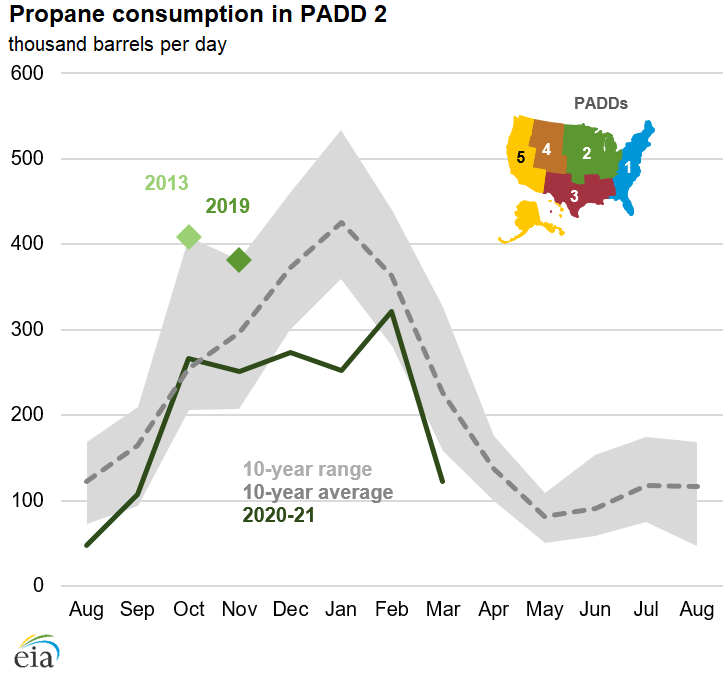 Source: U.S. Energy Information Administration, Petroleum Supply Monthly
Source: U.S. Energy Information Administration, Petroleum Supply MonthlyNote: Consumption is reported as product supplied.
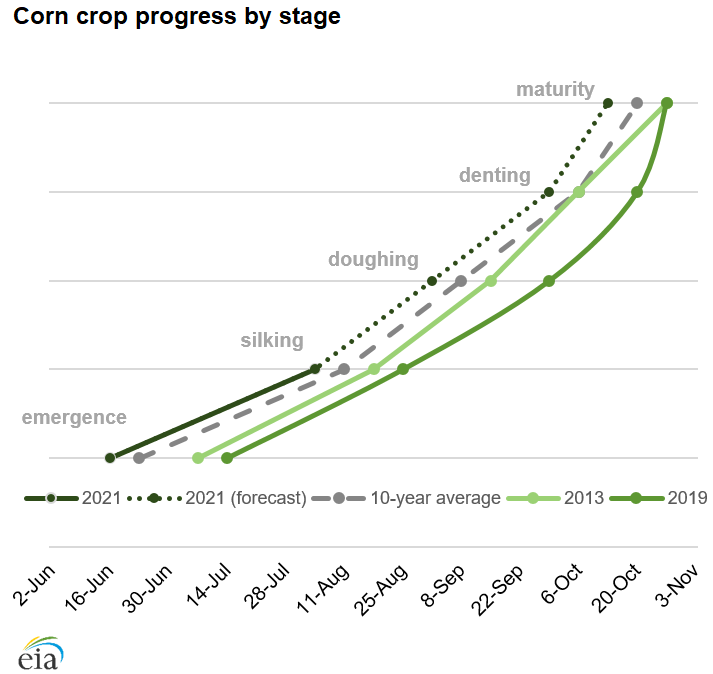 Source: Graph by the U.S. Energy Information Administration (EIA) based on data collected by the U.S. Department of Agriculture, National Agricultural Statistics Service
Source: Graph by the U.S. Energy Information Administration (EIA) based on data collected by the U.S. Department of Agriculture, National Agricultural Statistics ServiceNote: Corn maturity forecast is based on current crop progress indicators and assumption of future progress at the 10-year average weekly trend.
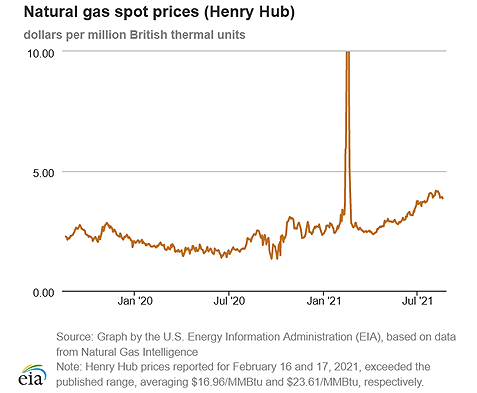
| Spot Prices ($/MMBtu) | Thu, 12-Aug |
Fri, 13-Aug |
Mon, 16-Aug |
Tue, 17-Aug |
Wed, 18-Aug |
|---|---|---|---|---|---|
| Henry Hub |
4.01 |
3.89 |
3.92 |
3.92 |
3.86 |
| New York |
3.90 |
3.57 |
3.71 |
3.79 |
3.83 |
| Chicago |
3.86 |
3.77 |
3.77 |
3.73 |
3.72 |
| Cal. Comp. Avg.* |
4.72 |
4.43 |
5.14 |
4.68 |
4.53 |
| Futures ($/MMBtu) | |||||
| September contract | 3.933 |
3.861 |
3.946 |
3.837 |
3.852 |
| October contract |
3.948 |
3.875 |
3.960 |
3.851 |
3.866 |
| *Avg. of NGI's reported prices for: Malin, PG&E Citygate, and Southern California Border Avg. | |||||
| Source: NGI's Daily Gas Price Index | |||||
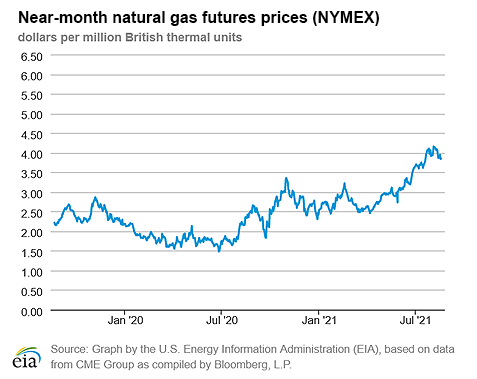
| U.S. natural gas supply - Gas Week: (8/12/21 - 8/18/21) | |||
|---|---|---|---|
Average daily values (billion cubic feet) |
|||
this week |
last week |
last year |
|
| Marketed production | 105.1 |
105.1 |
101.5 |
| Dry production | 93.0 |
92.9 |
90.6 |
| Net Canada imports | 4.9 |
4.9 |
4.9 |
| LNG pipeline deliveries | 0.1 |
0.1 |
0.1 |
| Total supply | 98.0 |
97.9 |
95.7 |
|
Source: Chart by the U.S. Energy Information Administration (EIA), based on data from IHS Markit | |||
| U.S. natural gas consumption - Gas Week: (8/12/21 - 8/18/21) | |||
|---|---|---|---|
Average daily values (billion cubic feet) |
|||
this week |
last week |
last year |
|
| U.S. consumption | 67.9 |
68.0 |
72.6 |
| Power | 38.7 |
38.8 |
43.6 |
| Industrial | 20.6 |
20.6 |
21.0 |
| Residential/commercial | 8.6 |
8.7 |
8.0 |
| Mexico exports | 6.1 |
6.3 |
5.8 |
| Pipeline fuel use/losses | 6.4 |
6.4 |
6.4 |
| LNG pipeline receipts | 10.7 |
9.8 |
4.7 |
| Total demand | 91.1 |
90.5 |
89.4 |
|
Source: Chart by the U.S. Energy Information Administration (EIA), based on data from IHS Markit | |||
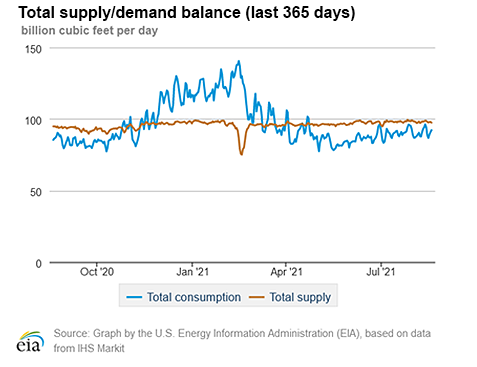
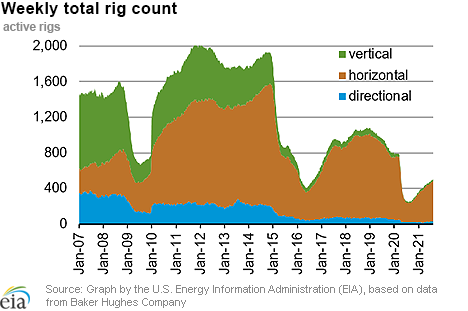
| Rigs | |||
|---|---|---|---|
Tue, August 10, 2021 |
Change from |
||
last week |
last year |
||
| Oil rigs | 397 |
2.6% |
130.8% |
| Natural gas rigs | 102 |
-1.0% |
45.7% |
| Note: Excludes any miscellaneous rigs | |||
| Rig numbers by type | |||
|---|---|---|---|
Tue, August 10, 2021 |
Change from |
||
last week |
last year |
||
| Vertical | 17 |
13.3% |
30.8% |
| Horizontal | 456 |
1.6% |
120.3% |
| Directional | 27 |
0.0% |
12.5% |
| Source: Chart by the U.S. Energy Information Administration (EIA), based on data from Baker Hughes Company | |||
| Working gas in underground storage | ||||
|---|---|---|---|---|
Stocks billion cubic feet (Bcf) |
||||
| Region | 2021-08-13 |
2021-08-06 |
change |
|
| East | 645 |
629 |
16 |
|
| Midwest | 765 |
741 |
24 |
|
| Mountain | 188 |
185 |
3 |
|
| Pacific | 240 |
241 |
-1 |
|
| South Central | 984 C |
979 |
5 |
|
| Total | 2,822 C |
2,776 |
46 |
|
|
Source: U.S. Energy Information Administration Form EIA-912, Weekly Underground Natural Gas Storage Report C=Reclassification Reclassifications from base gas to working gas resulted in increased working gas stocks of 4 Bcf in the South Central nonsalt region for the week ending August 13, 2021. The implied flow for the week is an increase of 42 Bcf to working gas stocks. (See Notes and Definitions for more information on "implied flow.") | ||||
| Working gas in underground storage | |||||
|---|---|---|---|---|---|
Historical comparisons |
|||||
Year ago (8/13/20) |
5-year average (2016-2020) |
||||
| Region | Stocks (Bcf) |
% change |
Stocks (Bcf) |
% change |
|
| East | 748 |
-13.8 |
694 |
-7.1 |
|
| Midwest | 877 |
-12.8 |
781 |
-2.0 |
|
| Mountain | 209 |
-10.0 |
190 |
-1.1 |
|
| Pacific | 313 |
-23.3 |
286 |
-16.1 |
|
| South Central | 1,222 |
-19.5 |
1,045 |
-5.8 |
|
| Total | 3,369 |
-16.2 |
2,996 |
-5.8 |
|
| Source: U.S. Energy Information Administration Form EIA-912, Weekly Underground Natural Gas Storage Report | |||||
| Temperature – heating & cooling degree days (week ending Aug 12) | ||||||||
|---|---|---|---|---|---|---|---|---|
HDDs |
CDDs |
|||||||
| Region | Current total |
Deviation from normal |
Deviation from last year |
Current total |
Deviation from normal |
Deviation from last year |
||
| New England | 0 |
-3 |
0 |
68 |
27 |
-2 |
||
| Middle Atlantic | 0 |
-3 |
0 |
80 |
26 |
10 |
||
| E N Central | 0 |
-5 |
-6 |
81 |
29 |
37 |
||
| W N Central | 0 |
-3 |
-3 |
85 |
20 |
24 |
||
| South Atlantic | 0 |
0 |
0 |
103 |
9 |
-2 |
||
| E S Central | 0 |
0 |
0 |
100 |
9 |
8 |
||
| W S Central | 0 |
0 |
0 |
132 |
9 |
-2 |
||
| Mountain | 0 |
-3 |
0 |
74 |
3 |
-9 |
||
| Pacific | 0 |
-2 |
-1 |
66 |
20 |
26 |
||
| United States | 0 |
-3 |
-2 |
89 |
18 |
12 |
||
|
Source: Chart by the U.S. Energy Information Administration (EIA), based on data from the National Oceanic and Atmospheric Administration Note: HDDs=heating degree days; CDDs=cooling degree days | ||||||||
Average temperature (°F)
7-day mean ending Aug 12, 2021
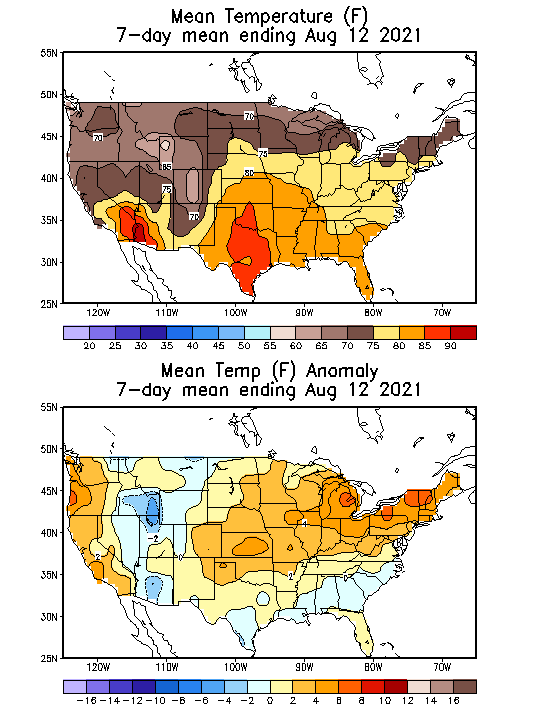
Source: National Oceanic and Atmospheric Administration
Deviation between average and normal (°F)
7-day mean ending Aug 12, 2021

Source: National Oceanic and Atmospheric Administration

